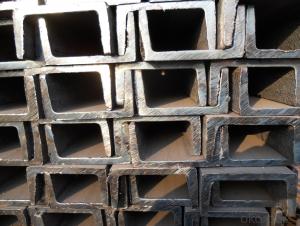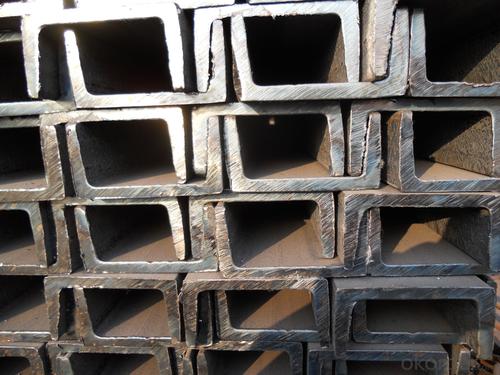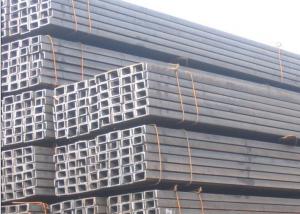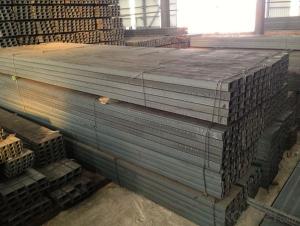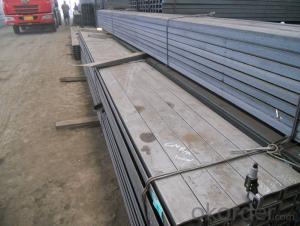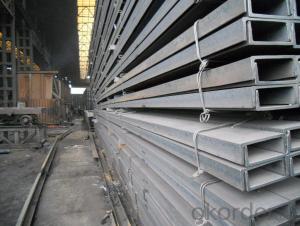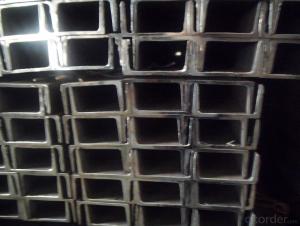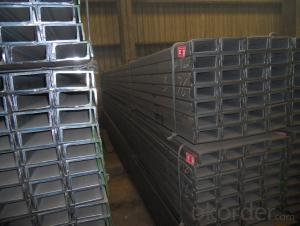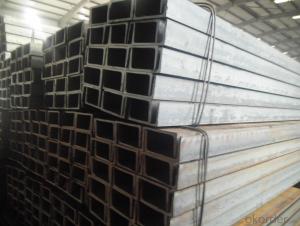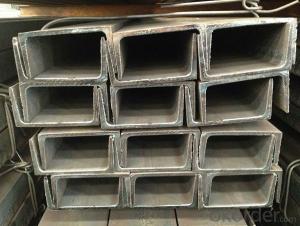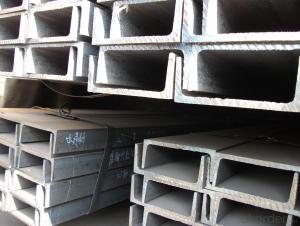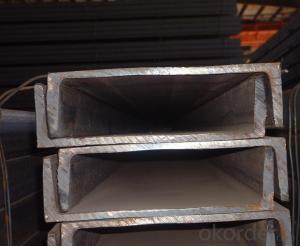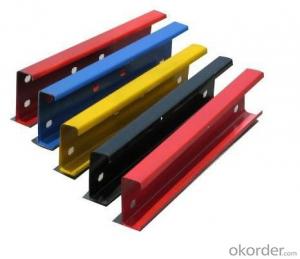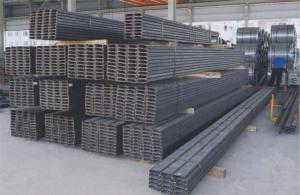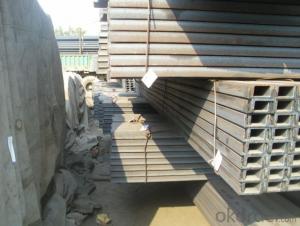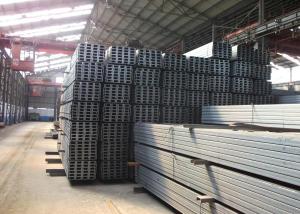Hot Rolled Steel U Channels with EN Standard for Construction
- Loading Port:
- China main port
- Payment Terms:
- TT or LC
- Min Order Qty:
- 25000 m.t.
- Supply Capability:
- 200000 m.t./month
OKorder Service Pledge
OKorder Financial Service
You Might Also Like
Specifications of Hot Rolled Steel U Channels with EN Standard for Construction:
1.Our UPN Channel Steel has lots of advantages, just as followings:
a) At reasonable price and good quality.
b) To be convenient in construction and to save much time and labor.
c) The length of UPN can be manufactured according to customer’s requirements.
d) The UPN Channel Steel has strong mechanical strength.
e). The UPN Channel Steel possesses various kind of fittings, through which it is suitbal for many combinations.
f) Our UPN Channel Steel is attractive in appearance as well as beautiful in design
g) Free from slotted punching
2. The detailed sections of our UPN Channel Steel can be found in table-1
UPN U CHANNEL | Standard h | Sectional b | Dimension s | t | Mass: Kg/m |
| (mm) | (mm) | (mm) | (mm) |
|
80x45 | 80 | 45 | 6.0 | 8.0 | 8.64 |
100X50 | 100 | 50 | 6.0 | 8.5 | 10.6 |
120x55 | 120 | 55 | 7.0 | 9.0 | 13.4 |
140x60 | 140 | 50 | 7.0 | 10.0 | 16.0 |
160x65 | 160 | 65 | 7.5 | 10.0 | 18.8 |
180x70 | 180 | 70 | 8.0 | 11.0 | 22.0 |
Table-1
Note: we are definitely good at manufacturing and supplying UPN channel steel as per S235JR. Also, we are willing and able to provide our customers UPN channel steel in other sizes, which depends on customers’ concret requirements for the quantity.
3. The chemical composition of UPN Channel Steel as per S235JR is shown in the table-2
Alloy No | Element(%) | ||||
C | Mn | S | P | Si | |
S235JR | 0.12—0.20 | 0.3—0.7 | ≤0.030 | ≤0.030 | ≤0.20 |
Table-2
4. The mechanical property of UPN Channel Steel as per S235JR is shown in the table-3-1 and table-3-2
Alloy No | Yielding strength point( Mpa) | |||
Thickness (mm) | ||||
≤16 | >16--40 | >40--60 | >60--100 | |
≥ | ||||
S235JR | 235 | 225 | 215 | 195 |
Table-3-1
Alloy No | Tensile strength (Mpa) | Elongation after fracture(%) | |||
Thickness (mm) | |||||
| ≤16 | >16--40 | >40--60 | >60--100 | |
≥ | |||||
S235JR | 340--510 | 24 | 23 | 22 | 27 |
Table-3-2
Applications of Hot Rolled Steel U Channels with EN Standard for Construction:
The UPN Channel Steel can be applied to construction of warehouses, workshops, sport stadiums and car parks etc.The hot rolled channel steel belongs to carbon structural steel which is applied to in the field of construction and machinery.In details, the hot rolled channel steel is usually used for arch-itechtural structure, and they could be welded in order to support or hang a vari-ety of facilities. They are also usually used in combination with I beam. Generally,the hot rolled channel steel we supply must possess perfect welding property, riveting property and mechanical property and so on.
Package & Delivery of Hot Rolled Steel U Channels with EN Standard for Construction:
1.The channel steel will be packed in bundle with steel wire at each end of every bundle and color marking in order to help the customer to recognize his goods more easily at sight.
2. And the channel steel could be loaded into 20ft or 40ft container, or by bulk cargo.If the weight of each bundle reaches more than 3.5 mt, the loading by break bulk cargo should be choosed.When the weight of each bundle reaches less than 3mt, the loading by container should be choosed.
3.As for the transportaion from mill to loading port, the truck will be usually used. And the maximum quantity for each truck is 40mt.
4.All in all, we could do in accordance with customer's request.
Production Flow of Hot Rolled Steel U Channels with EN Standard for Construction:
1.The steel billet shall be heated in the high temperature furnace.
2. The heated steel billet shall be rolled five to nine times with the aim of shaping the general figure of steel u channel.
3. The rolled steel u channel should be put onto the cooling bed to make the temperature low.
4. The steel u channel should be straighted on the straightener.
5. The straighted steel u channel will be cut into meters by saw, as per customer's requirements.
6. At the last part of production, the channel steel must be tested in order to confirm that the finished products are completely free from crack, pore, slag, scab or fold on the surface.
FAQ:
Q1: How soon can we receive the product after purchase?
A1: Within three days of placing an order, we will begin production. The specific shipping date is dependent upon international and government factors, but is typically 7 to 10 workdays.
Q2: What makes stainless steel stainless?
A2: Stainless steel must contain at least 10.5 % chromium. It is this element that reacts with the oxygen in the air to form a complex chrome-oxide surface layer that is invisible but strong enough to prevent further oxygen from "staining" (rusting) the surface. Higher levels of chromium and the addition of other alloying elements such as nickel and molybdenum enhance this surface layer and improve the corrosion resistance of the stainless material.
Q3: Can stainless steel rust?
A3: Stainless does not "rust" as you think of regular steel rusting with a red oxide on the surface that flakes off. If you see red rust it is probably due to some iron particles that have contaminated the surface of the stainless steel and it is these iron particles that are rusting. Look at the source of the rusting and see if you can remove it from the surface.
Images:
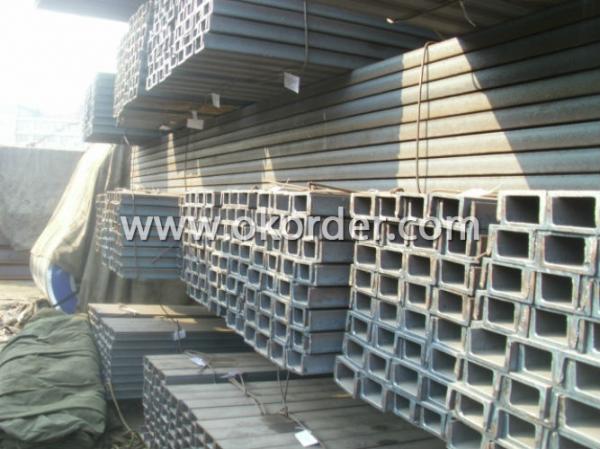
- Q: What are the different methods of protecting steel channels from impact damage?
- There are various methods of protecting steel channels from impact damage, including installing protective barriers or bollards, using impact-resistant coatings or paints, implementing cushioning materials or padding, employing shock-absorbing devices or systems, and reinforcing the structure with additional supports or reinforcements.
- Q: What are the applications of steel channels?
- Steel channels have a wide range of applications across various industries and sectors. One of the primary applications of steel channels is in the construction industry. They are commonly used as structural components in building frames, bridges, and other infrastructure projects. Steel channels provide strength, stability, and load-bearing capacity, making them suitable for supporting heavy loads and withstanding environmental factors such as wind, earthquakes, and extreme temperature variations. In addition to construction, steel channels also find extensive use in the manufacturing industry. They are often utilized in the production of machinery, equipment, and vehicles. Steel channels can be used as support structures in manufacturing plants, as well as in the fabrication of frames, conveyors, and racks. Their high strength-to-weight ratio makes them ideal for these applications. Steel channels are also used in the renewable energy sector, particularly in the construction of solar panel mounting systems and wind turbine towers. Due to their durability and resistance to corrosion, steel channels provide a reliable and sturdy framework for these renewable energy installations. The automotive industry is another area where steel channels are commonly employed. They are used in the chassis and body frames of automobiles to provide structural integrity and enhance safety. The strength and rigidity of steel channels make them an essential component in ensuring the stability and performance of vehicles. Moreover, steel channels are utilized in the manufacturing of storage systems such as shelving, racking, and warehouse systems. They provide a sturdy framework for organizing and storing products in various commercial and industrial settings. Overall, the applications of steel channels are vast and diverse, ranging from construction and manufacturing to renewable energy and automotive industries. Their strength, durability, and versatility make them an indispensable component in numerous sectors, contributing to the development of robust and reliable structures and equipment.
- Q: Can steel channels be used for guardrail systems?
- Indeed, guardrail systems can make effective use of steel channels. Given their robustness and endurance, steel channels frequently find application in construction and infrastructure endeavors. They offer a stable base and reinforcement for guardrail systems, thereby guaranteeing the safety and safeguarding of both pedestrians and vehicles. The fabrication and installation of steel channels are uncomplicated, rendering them a prudent and economical option for guardrail systems. Furthermore, steel channels exhibit remarkable resilience against inclement weather and corrosion, rendering them ideal for extended use in outdoor settings. In conclusion, steel channels are a dependable and widely employed material for the construction of guardrail systems.
- Q: How are steel channels protected against rust during construction?
- Steel channels are typically protected against rust during construction by applying a corrosion-resistant coating such as galvanization or paint. These protective coatings act as a barrier, preventing moisture and oxygen from reaching the steel surface, thus inhibiting the formation of rust. Additionally, proper storage and handling practices are followed to minimize exposure to moisture and ensure the integrity of the protective coatings.
- Q: How are steel channels used in the construction of shopping malls or retail centers?
- Steel channels are commonly employed in the construction of shopping malls or retail centers for various purposes. These elongated and narrow metal beams, which have a "U" or "C" shape, offer several advantages in terms of strength, versatility, and cost-effectiveness. One of the primary applications of steel channels in shopping mall or retail center construction is for providing structural support. These channels can be utilized to establish the framework or skeleton of the building, ensuring stability and rigidity in the overall structure. Steel channels are renowned for their high tensile strength and ability to bear heavy loads, making them an ideal choice for supporting multiple floors, ceilings, and roofs. Another use of steel channels in shopping mall construction is for the installation of mechanical, electrical, and plumbing (MEP) systems. These channels can be used to hide and safeguard various utility lines, such as electrical cables, HVAC ducts, and plumbing pipes. By employing steel channels, these systems can be routed securely and systematically throughout the building, remaining out of sight while still being easily accessible for maintenance or repairs. Furthermore, steel channels can also be employed for constructing partitions and walls within shopping malls or retail centers. These channels can serve as studs or tracks, creating the framework for interior walls or dividing spaces. By using steel channels for partition walls, builders can create flexible layouts that can be easily modified or reconfigured as needed, accommodating the ever-changing requirements of commercial tenants. Moreover, steel channels are often used in the construction of mezzanine floors or elevated platforms within shopping malls or retail centers. Mezzanine floors can be added to maximize available space and provide additional areas for retail or storage purposes. Steel channels are used to construct the supporting structure for these elevated platforms, ensuring they can bear the weight of people, products, and equipment. In conclusion, steel channels play a vital role in the construction of shopping malls or retail centers by offering structural support, facilitating the installation of MEP systems, constructing interior walls, and enabling the creation of mezzanine floors. Their strength, versatility, and cost-effectiveness make them an essential component in contemporary commercial construction, allowing for efficient and durable building solutions.
- Q: What are the factors that affect the cost of steel channels?
- The cost of steel channels can be affected by several factors. Firstly, the cost of raw materials plays a significant role. Factors like supply and demand, production costs, and global economic conditions can directly impact the price of steel, thus affecting the cost of steel channels. Another factor that influences the cost is the size and specifications of the channels. Larger or more specialized channels may require additional processing or customization, leading to increased costs. The complexity of the design or the need for specific coatings or finishes can also impact the final price. The manufacturing process itself contributes to determining the cost. Different production methods, such as hot-rolling or cold-forming, have varying associated costs. Additionally, the location of the steel production facility and transportation costs can affect the overall price. Market conditions and competition also have a role in determining the cost of steel channels. When demand is high and supply is limited, prices tend to rise. Conversely, during periods of low demand or increased competition, prices may decrease. Lastly, any additional services or value-added features, like cutting, drilling, or welding, can increase the cost of steel channels. These services require additional labor, equipment, and expertise, resulting in an overall higher price. In conclusion, the cost of steel channels is influenced by various factors, including raw material prices, size and specifications, manufacturing process, market conditions, competition, and additional services. It is crucial for businesses and consumers to understand these factors in order to make informed decisions when purchasing steel channels.
- Q: How do you calculate the load capacity of steel channels?
- To determine the load capacity of steel channels, one must take into account various factors, such as the channel's dimensions and properties, the type of loading, and the safety factor. Initially, the dimensions of the steel channel, including its height, width, and thickness, need to be determined. These dimensions are essential for calculating the load capacity. Next, the material properties of the steel channel, such as the modulus of elasticity and yield strength, must be identified. These properties provide information regarding the channel's ability to withstand deformation and failure under load. The type of loading also plays a significant role in determining the load capacity. There are different types of loading, namely axial compression, bending, and shear. Each type requires a distinct calculation method. For axial compression, Euler's formula can be used to calculate the load capacity. This formula involves considering the effective length of the channel, the moment of inertia, and the modulus of elasticity. In the case of bending, the load capacity can be determined by calculating the maximum moment the channel can withstand before yielding. This calculation necessitates taking into account the moment of inertia and the yield strength of the steel. When it comes to shear, the load capacity calculation entails considering the shear strength of the steel channel. This strength is determined by the cross-sectional area and the ultimate shear strength of the material. Lastly, it is vital to incorporate a safety factor to ensure the channel can handle unforeseen variations in load. The safety factor, typically greater than 1, accounts for uncertainties in the calculation and potential overloading. In conclusion, calculating the load capacity of steel channels involves considering dimensions, material properties, type of loading, and employing appropriate formulas. Including a safety factor is crucial to ensure the channel can safely bear the expected load.
- Q: Are steel channels suitable for agricultural buildings?
- Yes, steel channels are suitable for agricultural buildings. They are strong and durable, making them ideal for supporting the structure and withstanding the harsh conditions often found in agricultural settings. Additionally, steel channels can be easily customized and fabricated to meet specific design requirements, making them versatile for various applications within agricultural buildings.
- Q: Can steel channels be used for solar panel installations?
- Certainly, solar panel installations can make use of steel channels. The reason steel channels are frequently employed as a mounting structure for solar panels lies in their robustness and longevity. They offer a firm framework for securely fastening the panels, guaranteeing their ability to endure diverse weather conditions and maintain their position for an extended duration. Moreover, steel channels can be effortlessly tailored and welded to cater to the unique needs of the solar panel installation, rendering them a versatile selection for this purpose. In conclusion, steel channels are a dependable and widely favored choice for securely and effectively mounting solar panels.
- Q: How do steel channels perform under dynamic loads?
- Known for their high strength and load-bearing capacity, steel channels are ideal for effectively handling dynamic loads. Vibrations, impacts, and fluctuating forces are easily managed by steel channels, as they exhibit exceptional performance and durability. The structural design of steel channels allows for the efficient dispersion of dynamic loads throughout their length, effectively preventing localized stress concentrations. This characteristic is critical in applications that involve repeated loading, as it minimizes the risk of fatigue failure. Moreover, steel channels possess excellent stiffness, enabling them to maintain their shape and integrity when subjected to dynamic loads. This stiffness ensures the overall stability and safety of the structure, as it resists bending, twisting, and deformation. Additionally, steel channels have a high level of ductility, meaning they can withstand significant deformation without fracturing. This is crucial in scenarios involving dynamic loading events, like impacts or earthquakes, as it reduces the likelihood of catastrophic failure by absorbing and dissipating energy. Furthermore, steel channels are often used in conjunction with other structural components, such as bolts, welds, or connectors, to enhance their load-bearing capacity. By combining steel channels with these reinforcements, their resistance to shear, torsion, and bending forces is further increased, resulting in improved performance under dynamic loads. In conclusion, steel channels are an excellent choice for handling dynamic loads due to their impressive strength, exceptional load distribution capabilities, stiffness, ductility, and compatibility with reinforcements. These qualities make them a reliable option for various applications that require the ability to withstand dynamic forces, guaranteeing the durability and safety of the structures in which they are utilized.
Send your message to us
Hot Rolled Steel U Channels with EN Standard for Construction
- Loading Port:
- China main port
- Payment Terms:
- TT or LC
- Min Order Qty:
- 25000 m.t.
- Supply Capability:
- 200000 m.t./month
OKorder Service Pledge
OKorder Financial Service
Similar products
Hot products
Hot Searches
Related keywords
